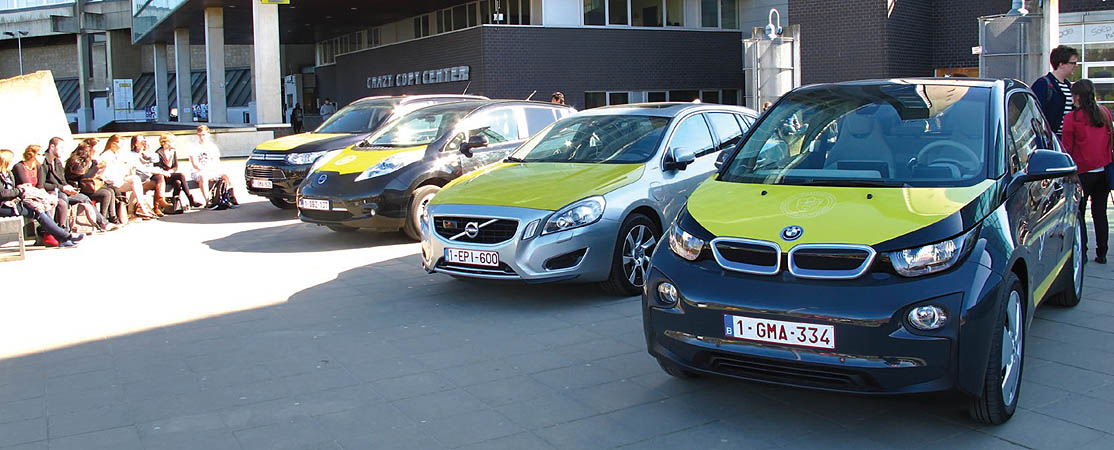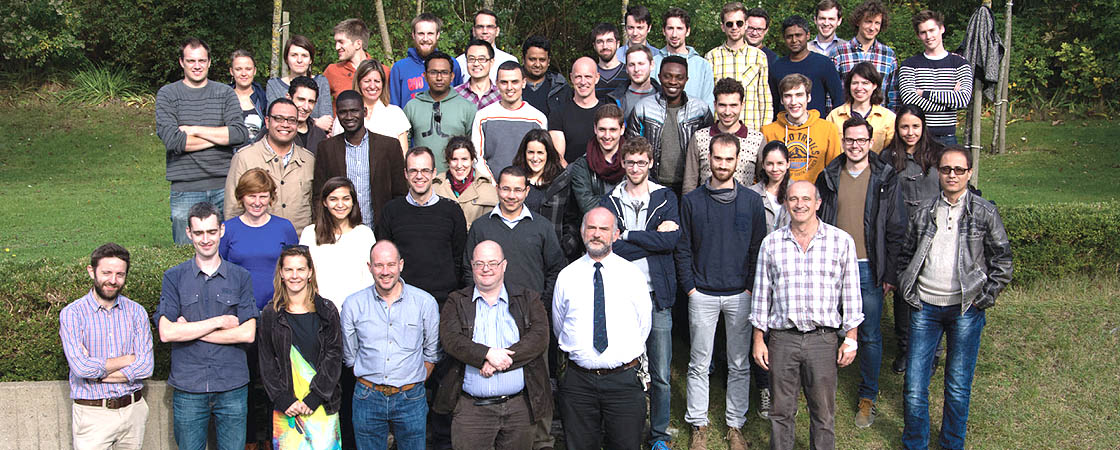While climate change sparks interest in electric vehicles, it raises questions as well. Professor Joeri Van Mierlo from the MOBI research group at Vrije Universiteit Brussel tackles them one by one.
 Climate change, local air pollution and the economic dependency on imported oil requires solutions to these severe issues. The transportation sector is responsible for more than 20% of the global warming emission, more than 50% of the NOx emissions in Europe and 25% of the PM emission, harming our human health. Another striking figure is the billon a day Europe is exporting out of its economy to import crude oil. Without no doubt, we must find alternatives in the transportation sector.
Climate change, local air pollution and the economic dependency on imported oil requires solutions to these severe issues. The transportation sector is responsible for more than 20% of the global warming emission, more than 50% of the NOx emissions in Europe and 25% of the PM emission, harming our human health. Another striking figure is the billon a day Europe is exporting out of its economy to import crude oil. Without no doubt, we must find alternatives in the transportation sector.
Modal shift from passenger cars towards walking, biking and public transportation is needed. But as the use of private cars is a dominant transport mode, one needs to find technical solutions for environmental friendly vehicles too.
ARE ELECTRIC VEHICLES REALLY THE BEST SOLUTION FOR THE ENVIRONMENT?
The short answer is yes. When discussing environmental impact, it is important to take into account the full life cycle of a vehicle. We have developed at the Vrije Universiteit Brussels reliable scientific models for this purpose. This allows looking beyond emissions from the vehicle itself to the environmental impact of batteries, the production of electricity and beyond.
In a full life cycle, electric vehicles emit two times less carbon dioxide (CO2) in comparison to diesel engines if we take the European electricity mix. This can be even 4 times less is we take for example the Belgian electricity mix. If cars were driving on sustainable electricity, carbon dioxide emissions could be further reduced by a factor of 15. And this is the way to go.
If we look at vehicles from a “well-towheel” perspective, electric vehicles produce four times less particulates and 20 times less nitrogen oxides (NOx) (Belgian example) compared to conventional vehicles. However, we need to stress that the exploitation and mining of raw materials in South America and China leaves much room for improvement. Recycling can further reduce the environmental impact. Car manufacturers have already made considerable efforts to reduce emissions of conventional cars in general however; reducing NOx remains a challenge, in particular for diesel vehicles.
As far as CO2 goes, diesel engines exhaust 20% less in comparison to petrol. Yet the difference between both fuels is annually decreasing. Also biofuels produce 40 to 60% less greenhouse gasses, but they do not significantly improve air quality. Moreover, we need surfaces as large as 2 football fields to power one car per year. We do not have the space in Europe and would therefore move this supply problem to other countries with many undesired side effects
There are other fuels such as natural gas or liquefied petroleum gas (LPG). They have a less negative impact on air quality and are thus better for our health. On the other hand, however, they do not offer a real solution for climate change. In order to counter climate change we need to switch our entire transport and energy sectors to non-fossil fuels. Electric vehicles have the potential to drive on solar and wind power.
It is not so easy to compare all the alternatives. But fortunately we have scientific methods to do this for us, namely life cycle analysis models (LCA) to compare all these factors in an unbiased way. If we take into account both climate change and air quality, the difference between petrol, diesel, LPG and natural gas driven cars is minimal. Hybrid and plug-in hybrid vehicles can improve scores with a factor two. The overall environmental impact of battery-electric vehicles can be up to five times smaller than conventional fuels, in case we consider for example the Belgian electricity mix.

Sometimes we hear that hydrogen is the true and only zero emission solution. Yet, also hydrogen needs to be produced. If we produce hydrogen with natural gas there is no advantage as far as greenhouse gases go. So you need to produce hydrogen from sustainable energy sources such as wind, sun or water. But the problem is that you need three times more wind turbines to drive a hydrogen-powered car in comparison to a battery-electric vehicle.
HOW DO ELECTRIC VEHICLES AFFECT OUR ECONOMY?
Research indicates that the electrification of our transport system would generate one million additional jobs in Europe in 2030 and double in 2050. These jobs relate to the production of components for electric vehicles. But they also relate to new services, such as charging infrastructure for example. Electrification is also positive to reduce our oil dependency. The import of oil costs the European economy one billion euro per day. Investing this in our own economies could mean a vast improvement on employment rates. Families could increase their purchasing power when they no longer need to depend on imported oil products.
"ELECTRIFICATION OF TRANSPORT GENERATES EMPLOYMENT AND REDUCES OIL DEPENDENCY"
It is suggested however that loss of income from duties and taxes on diesel and petrol will negatively impact government budgets. But this does not take into account improved air quality. Improved air quality will have a positive effect on the health budget. Less expenses for health care, but also cleaning of monuments and historical buildings for example. These are not wild guesses. MOBI developed an ‘External Cost Calculator’, which can provide well-founded data. Policy makers can use these to make better informed decisions.
WHAT WILL OUR VEHICLE FLEET LOOK LIKE IN 2050?
Apart from electric cars, self-driving or autonomous vehicles will have made their appearance by 2050. Even though both technologies are not dependent on each other, electric cars are better candidates to become self-driving cars. Autonomous cars depend on electronics for their control. It therefore makes sense to equip them with an electric motor. The autonomous vehicles, which we can expect on the market the coming decades, need different charging infrastructure then the electric vehicles which are coming onto the market now. The self-driving car from 2050 will seek its own charging point when it needs to and charging points will therefore be organised differently and in other locations, allowing smart grid operations. It will be no longer necessary to own a car but define your needs. In your smartphone you plan your car, like you plan other items in your agenda. At 7am a fully charged vehicle will be waiting on your door step. When you return, the car will return to its automated charging station.
WILL ELECTRIC DRIVING CAUSE POWER SHORTAGES?
Suppose that 10% of our fleet would be electric, this would only mean an additional demand for electricity of 1,4%. We should not forget that the introduction of renewable energy sources is gearing up. Their share in the production of energy will only increase. It does create other issues though. What if there is no wind and sun? At these moments we either need to rely on other sources or we need to invest more in energy storage. The battery of an electric vehicle can play an important role in energy storage.
When too much electricity is produced, it can be stored in the batteries of cars. When there is not sufficient electricity, they give it back to the grid. This is what has been called V2G or ‘vehicle to grid’. Furthermore second life batteries will makes electric vehicles more economically attractive. Will there be enough electric cars to envisage this? We do indeed need a large fleet of electric vehicles to realise this and those are entering the market rather slowly. In anticipation of this gradual introduction, we need to rethink our electric supply system drastically if we want to increase the share of renewable energy sources.
In other words, our grid will need to be remodelled, even independent from the introduction of electric vehicles, purely because of the need to increase the share of renewable energy sources.
V2G applications have an impact on the life expectancy of the battery of an electric car. It is therefore important to research how we can give batteries a ‘second life’ and how they can be recycled. If the capacity of a vehicle battery declines to 80%, we assume it is no longer serviceable. Yet it still has 80% storage capacity. So it could be used for other applications, such as to support the grid, for micro-grids or home storage, etc.
HOW FAR CAN YOU GET IN AN ELECTRIC CAR?
Driving range is an important issue and depends on many factors, first of which of course the battery. In a Tesla you can cover 400km today, but the typical autonomy of electric cars is more in the range of 150km. However, things are changing fast. More and more car manufactures are bring electric cars on the market with a driving distance of around 400km and this at acceptable prices ranges. Driving range is also dependent on driving style, weather conditions and the desired comfort. If you would like a temperature of 22 degrees in your car in the middle of winter, this demands a lot of energy from your battery. Yet manufacturers are looking into to tackling these issues too.
For the average consumer driving range is a key factor when considering a car. We call this ‘range anxiety’. Yet more than 95% of our daily trips are less than 100km. 30% of all our vehicles never drive more than 100km per day. We could make a start replacing these 30% with electric vehicles. Yet consumers have a tendency to upscale their car for the occasional longer trip. Most of the cars on our roads are oversized, with a large trunk for the annual summer holiday.
The need for public charging infrastructure is dependent upon families owning a garage. In cities this is a problem. Less then 11% of families in Brussels for example have a private garage. Apart from standard charging points, fast chargers will find their place on motorways, in cities and in suburban areas. These fast chargers can fully charge a battery in 15 to 25 minutes.
The development of batteries is taking fast leaps forward. MOBI’s Battery Innovation Centre performs groundbreaking research in collaboration with key European players.
WILL EVERYONE DRIVE ELECTRIC VEHICLES IN THE NEAR FUTURE?
No more combustion engines. Breathing clean air in our cities, hearing birds instead of traffic. Is it an unrealistic vision for the future? The reality is that we cannot change an entire fleet overnight. The average lifetime of a car is 14 years. In other words, if you buy a diesel car today, it will still be on the road in 2030.
Nevertheless we are at a turning point. It is not just diesel gate that drives the market. Tesla has opened the market by offering models that go way beyond the small city car. A whole new type of consumers is now interested in electric cars. All manufacturers are working on electric models. So things are moving.
On the basis of MOBI’s consumer behaviour models, we predict that by 2020 about 5 to 10% of new cars sold in Belgium will be electric. We also depend on policy makers and the incentives they offer. As a result of fiscal policy, in Norway for example the best selling car is not petrol or diesel but an electric car.
But we still have not answered the question about the number of electric cars in 2050. Or should we look at the issue from a different perspective? How many electric cars do we need by 2050 to generate additional employment, improve our health and quality of life and slow down climate change?

Professor Joeri Van Mierlo is Director of MOBI: Mobility, Logistics and Automotive Technology Research Centre. He lectures at the Vrije Universiteit Brussel and is an internationally recognised expert in the field of electric vehicles.
He is the Vice president of the European Electric vehicle association (www.avere.org) and the scientific chairman of the International Electric Vehicle Symposium EVS30 (www.evs30.org).